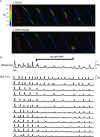Calcium oscillations in interstitial cells of the rabbit urethra
- PMID: 15760947
- PMCID: PMC1464513
- DOI: 10.1113/jphysiol.2004.078097
Calcium oscillations in interstitial cells of the rabbit urethra
Abstract
Measurements were made (using fast confocal microscopy) of intracellular Ca2+ levels in fluo-4 loaded interstitial cells isolated from the rabbit urethra. These cells exhibited regular Ca2+ oscillations which were associated with spontaneous transient inward currents recorded under voltage clamp. Interference with D-myo-inositol 1,4,5-trisphosphate (IP3) induced Ca2+ release using 100 microm 2-aminoethoxydiphenyl borate, and the phospholipase C (PLC) inhibitors 2-nitro-4-carboxyphenyl N,N-diphenylcarbamate and U73122 decreased the amplitude of spontaneous oscillations but did not abolish them. However, oscillations were abolished when ryanodine receptors were blocked with tetracaine or ryanodine. Oscillations ceased in the absence of external Ca2+, and frequency was directly proportional to the external Ca2+ concentration. Frequency of Ca2+ oscillation was reduced by SKF-96365, but not by nifedipine. Lanthanum and cadmium completely blocked oscillations. These results suggest that Ca2+ oscillations in isolated rabbit urethral interstitial cells are initiated by Ca2+ release from ryanodine-sensitive intracellular stores, that oscillation frequency is very sensitive to the external Ca2+ concentration and that conversion of the primary oscillation to a propagated Ca2+ wave depends upon IP3-induced Ca2+ release.
Figures










Similar articles
-
Properties of spontaneous Ca2+ transients recorded from interstitial cells of Cajal-like cells of the rabbit urethra in situ.J Physiol. 2007 Sep 1;583(Pt 2):505-19. doi: 10.1113/jphysiol.2007.136697. Epub 2007 Jul 5. J Physiol. 2007. PMID: 17615099 Free PMC article.
-
Inositol-1,4,5-trisphosphate-mediated spontaneous activity in mouse embryonic stem cell-derived cardiomyocytes.J Physiol. 2007 Jun 15;581(Pt 3):1113-27. doi: 10.1113/jphysiol.2006.125955. Epub 2007 Mar 22. J Physiol. 2007. PMID: 17379641 Free PMC article.
-
Calcium transient activity in cultured murine neural crest cells is regulated at the IP(3) receptor.Brain Res. 2000 Apr 17;862(1-2):201-10. doi: 10.1016/s0006-8993(00)02128-4. Brain Res. 2000. PMID: 10799686
-
Origin of spontaneous rhythmicity in smooth muscle.J Physiol. 2006 Jan 1;570(Pt 1):23-8. doi: 10.1113/jphysiol.2005.098376. Epub 2005 Oct 20. J Physiol. 2006. PMID: 16239271 Free PMC article. Review.
-
Ca2+ signalling in urethral interstitial cells of Cajal.J Physiol. 2006 Nov 1;576(Pt 3):715-20. doi: 10.1113/jphysiol.2006.115956. Epub 2006 Aug 17. J Physiol. 2006. PMID: 16916912 Free PMC article. Review.
Cited by
-
Ca2+ -activated Cl- channels (TMEM16A) underlie spontaneous electrical activity in isolated mouse corpus cavernosum smooth muscle cells.Physiol Rep. 2022 Nov;10(22):e15504. doi: 10.14814/phy2.15504. Physiol Rep. 2022. PMID: 36394209 Free PMC article.
-
Novel excitatory effects of adenosine triphosphate on contractile and pacemaker activity in rabbit urethral smooth muscle.J Urol. 2010 Feb;183(2):801-11. doi: 10.1016/j.juro.2009.09.075. J Urol. 2010. PMID: 20022059 Free PMC article.
-
Effects of imatinib mesylate on spontaneous electrical and mechanical activity in smooth muscle of the guinea-pig stomach.Br J Pharmacol. 2008 May;154(2):451-9. doi: 10.1038/bjp.2008.91. Epub 2008 Apr 14. Br J Pharmacol. 2008. PMID: 18414381 Free PMC article.
-
Electrical slow waves in the mouse oviduct are dependent on extracellular and intracellular calcium sources.Am J Physiol Cell Physiol. 2011 Dec;301(6):C1458-69. doi: 10.1152/ajpcell.00293.2011. Epub 2011 Aug 31. Am J Physiol Cell Physiol. 2011. PMID: 21881003 Free PMC article.
-
Spontaneous activity of lower urinary tract smooth muscles: correlation between ion channels and tissue function.J Physiol. 2006 Jan 1;570(Pt 1):13-22. doi: 10.1113/jphysiol.2005.097311. Epub 2005 Oct 6. J Physiol. 2006. PMID: 16210349 Free PMC article. Review.
References
-
- Aoyama M, Yamada A, Wang J, Ohya S, Furuzono S, Goto T, Hotta S, Ito Y, Matsubara T, Shimokata K, Chen SR, Imaizumi Y, Nakayama S. Requirement of ryanodine receptors for pacemaker Ca2+ activity in ICC and HEK293 cells. J Cell Sci. 2004;117:2813–2825. 10.1242/jcs.01136. - DOI - PubMed
-
- Bayguinov O, Hagen B, Bonev AD, Nelson MT, Sanders KM. Intracellular calcium events activated by ATP in murine colonic myocytes. Am J Physiol Cell Physiol. 2000;279:C126–135. - PubMed
-
- Boittin FX, Coussin F, Macrez N, Mironneau C, Mironneau J. Inositol 1,4,5-trisphosphate-and ryanodine-sensitive Ca2+ release channel-dependent Ca2+ signalling in rat portal vein myocytes. Cell Calcium. 1998;23:303–311. - PubMed
Publication types
MeSH terms
Substances
Grants and funding
LinkOut - more resources
Full Text Sources
Miscellaneous

